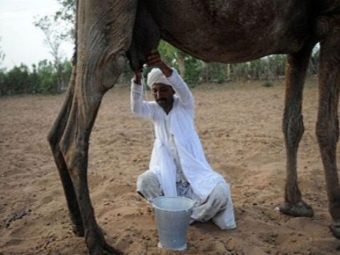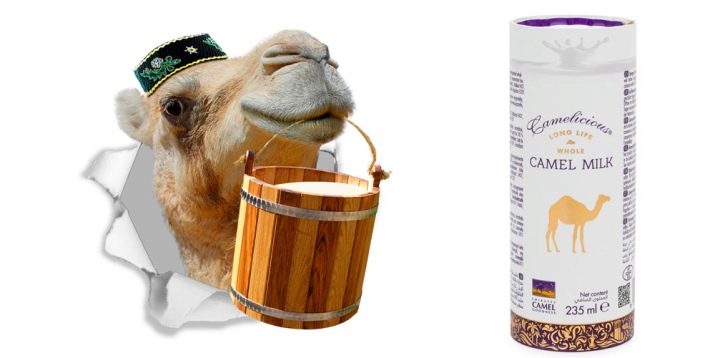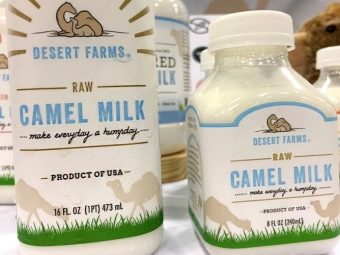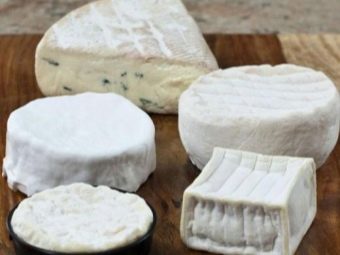Properties and caloric content of camel milk
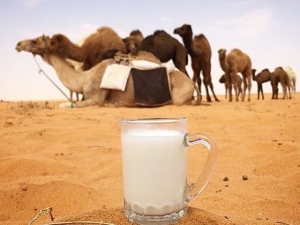
Today, there are various types of dairy products from around the world: cow, goat, mare's milk. Among them is such a famous product as camel milk, which is highly valued for its healing properties and is also widely used in the preparation of famous national dishes.
Characteristic
Camel's milk has its name due to the method of production: by making milk by a female camel. It is issued, and the resulting product is used for its intended purpose. In the day the animal gives up to five liters of fresh milk. And the camel will be milked only in the presence of her cub.
Camel milk is a habitual drink for residents of Eastern and Asian countries, it has a characteristic taste that depends on many factors, which also include the quality of food and the amount of water consumed by animals.
For more than three thousand years, this product is included in the diet of many peoples of the East, Asia and Africa, as well as Europe and America. Every year the geography of consumption of this product increases, and the list of healing qualities increases in direct proportion to this process.
Camel milk has a thick texture and foam, almost does not deteriorate due to the presence in the composition of lactoferrin - a natural natural antibiotic. It is sweeter, tastier and healthier than cow's milk., as it is a more environmentally friendly food product. Camels are far from industrial and man-made zones.
Contrary to universal belief, camel's milk has a little fat content. Moreover, in two-humped specimens, milk is much fatter than that of their one-humped brethren because, due to the nature of their structure, they are able to store more nutrients.
Camel milk is called Bedouin drink. The product can be frozen without fear that it will lose its properties and turn sour.
Composition, nutritional value and calorie
The composition of camel's milk includes valuable fatty acids, vitamins A, C, E, B, K, D, micro- and macroelements, minerals: magnesium, potassium, calcium, zinc, phosphorus, sodium, selenium and other useful substances.
The content of BZHU in this product is almost the same as in cow's milk. But at the same time, camel milk has a lower calorific value and fat and is considered a dietary product. And 100 grams of the product contains 82 Kcal, proteins - 3.9 g, fat - 4.5 g, carbohydrates - 4.9 g. The same amount of cow's milk contains 110 calories and 8 grams of saturated fat. The fat content of camel milk is 2-3%, rarely up to 5%.
The chemical composition of this product is significantly different from similar. The main difference lies in the special structure of the protein, as well as its content. In the product, this figure reaches about 200 protein units. In addition, it does not contain lactoglobulin and casein, which are found in ordinary cow and goat's milk. Instead of casein acids, camel milk contains a complex of beta-casein, due to which it is a hypoallergenic food product.
Several reasons why you should eat camel milk.
- It consists of groups of protein-immunomodulators, which have antiviral and anti-pathogenic properties. A powerful amount of immunoglobulin and its specific formula gives the human body indispensable protective and restorative properties. Having a similar structure to human, protein molecules interact with affected cells and tissues. Therefore, this drink is advised to drink for the prevention and treatment of autoimmune diseases.
- The insulin substances of animal origin which are part of milk have a similar structure with human. Therefore, it is advised to use insulin-dependent people, as well as people with diabetes.
- Camel milk contains a lot of iron, so it is used for anemia and other diseases of the blood and endocrine system.
- The product is similar to women's breast milk, so it can be used for feeding babies.
The composition of camel milk can vary in quantitative equivalent of nutrients and minerals. This is due to the diet of the milk donor, as well as the method of storage and processing of the original product.
Heat treatment during pasteurization reduces the vitamin content, and when combined with milk of other breeds of animal husbandry, it only loses. So nutritionists recommend eating camel milk in its pure form.
Benefit and harm
Due to the presence of vital components, camel's milk has healing properties:
- restores blood rheology and normalizes cell respiration;
- promotes the regeneration of tissues and bones, and also improves the condition of the skin, teeth, hair and nails;
- strengthens the protective barrier of immunity;
- reduces the risk of osteoporosis and rheumatism;
- destroys the dangerous effects of free radicals, radionuclides and toxic substances;
- cleans the liver and the body of toxins;
- helps to reduce cholesterol levels, burns extra pounds, and also contributes to the normalization of blood sugar;
- normalizes cardiac activity, as well as the human vascular, nervous and endocrine systems;
- cures insomnia, eliminates anxiety and stress;
- restores water-salt metabolism, protects the body from dehydration;
- restores intestinal microflora, cures gastrointestinal diseases, promotes healing of cicatricial wounds, purulent and skin diseases;
- cures diseases of the genitourinary system;
- suppresses inflammatory processes caused by metabolic disorders;
- used in the cosmetics industry as an ingredient in skin and hair care lines.
It is also useful to drink this product to expectant mothers and even add it to tea during breastfeeding. Then problems with milk will never happen.
Recent studies by scientists have proved the benefits of camel milk in the treatment of cancer, tumors and oncology of various degrees.
The use of this tool in traditional medicine is recorded in historical documents a thousand years ago. So, on the basis of camel milk, they prepared an internal remedy for liver disease (now they would say cirrhosis), drying the cheese balls with the addition of medicinal ingredients: herbs and spices. With the help of koumiss, this milk was used to get rid of dropsy, swelling and fluid retention in the body, and “sick” water was removed. In the treatment of skin rashes and other disorders of unknown etiology was not equal to camel's milk.
This foamy drink of the desert was valued in its time above gold and spices. And now its healing potential is not fully understood.
Along with the benefits, milk has its contraindications. This product should not be taken:
- with individual intolerance and allergic reactions;
- with casein and lactose intolerance;
- during initial use, diarrhea and dyspeptic conditions are possible, which disappear when the organism is used to the product.
Product selection and storage methods
Camel's milk can last for a long time and perfectly tolerates transportation. It is customary to store it in a refrigerator at a temperature of ± 2 degrees Celsius. The shelf life of finished products from camel milk should not exceed five days, subject to the appropriate temperature conditions. Salted foods, such as cheeses, are stored longer, and dairy products, yogurts are only a few hours.
To choose a product in packages or plastic costs no signs of bloating. Expired milk cannot be drunk. In a glass container the drink is stored longer. However, direct sunlight should be avoided and bottles should be protected from overheating.
Application features
Camel's milk product is used in various recipes.Kazakhs based on it prepare dairy products such as koumiss or shubat. Residents of Switzerland add camel's milk to chocolate. It produces various types of ice cream, cooks porridges, sauces, puddings, adds to pastries, salads, sweet desserts and milk drinks.
Dairy products are prepared from it: chalap, koumiss, laban, labne, cream and melted butter, cheese, cottage cheese and kefir.
Camel milk is combined with other similar products and prepare national dishes:
- spicy cheese - kurt and izhegay kurt;
- colostrum;
- sour butter - Irket May;
- sour milk - katyk;
- cottage cheese - suzba - based on katyk.
There are no rules for eating camel milk. Therefore, adhere to the general recommendations for the use of this type of product:
- milk should be drunk an hour before or after meals;
- at one time should not use more than 500 grams of the product;
- you can not boil the milk, because it immediately rolled into cottage cheese.
Do not forget that this is a medicinal and dietary product; at first it should be strictly dosed and courses. When the main components of camel's milk are involved in the metabolism, it is possible to make its use constant. But it will take time: on average, about a crescent.
Consumers around the world note the healing properties of camel milk, as well as products based on it. At home drink consumed constantly. In Europe, this product is included in the menu of restaurants as exotic dishes.
Shubat in national execution
According to reviews, the most common is shubat (aka kimyran or chal). In the Kazakh version, camel's milk is mixed with the already prepared chal in proportions: one fourth of the milk is one fourth of the leaven. All the ingredients are put into pottery with a high neck in layers: a layer of milk - a layer of chala, and so on, until the end. After a couple of minutes everything is mixed. Fermentation will occur at natural ambient temperatures. In the East, it is, on average, + 26-30 degrees.
Next, put the jug in the shade, wrapped in towel dipped in well water. As it dries, it is impregnated again. Somewhere in an hour, the jug is unrolled and the cream-agar is removed from the surface and the composition is left to dry for another four hours. The cream produces a delicious butter and cream for the cake.
Every half hour the container with a drink should be shaken, and then gradually filled with fresh camel milk. The finished product is stored no more than a day, then it is placed in a refrigeration chamber, where it can stay for quite a long time, sometimes up to two weeks.
Before use, it is recommended to dilute the starter with water in arbitrary proportions.
How to make a drink at home?
If it is not possible to cook shubat according to the steppe recipe, use the urban cooking option. He is most adapted to our conditions. So, if there is no place to take ready ferment for a chale, pharmaceutical bacteria and ordinary kefir will fit.
Half a liter of camel milk is poured into a saucepan or any other container, 100 grams of milk powder are added and half a cup of sourdough is put. It is prepared separately, diluting the lactobacilli in kefir at the rate of: one ampoule of the dry preparation, diluted in a teaspoon of water - per cup of fresh kefir. All ingredients are mixed and left in a warm room for a day. 40 minutes after the first mixing, remove the cream and continue to mix every hour. After the product is insisted and "entered into force", it is stored in the refrigerator for several days. The main thing - you need to make sure that the drink does not ferment. It is impossible to drink the spoiled product, it is possible to provoke a dysbacteriosis and diarrhea.
Previously, chal was cooked with cattle pasture. Camel milk was diluted with yeast and run into a waterskin that was attached to the saddle. In such a simple way, the drink was prepared very quickly. In the cold season, they drank the drink, throwing warm water in proportions of one to one.Such a product was pleasantly warming and giving strength. You can try these recipes and recommendations and make a tasty, nutritious and healing drink for yourself and your family.
To learn how useful camel milk is, see the following video.


